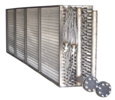10 Interesting Facts About HVAC Coils

At Emergent Coils, we want to make sure you select the best HVAC coils for your needs. Part of my job involves educating customers about different types of HVAC coils, so this blog post covers a wide range of coils.• In HVAC coils, tubes are responsible for approximately 30% of heat transfer and fins are responsible for the other 70%. Keep this in mind when selecting materials.• The construction of hot water coils and chilled water coils is the same. Hot water coils are typically 1 or 2 rows and chilled water coils are typically 3 to 12 rows.• Booster coils are designed for heating applications using hot water and are usually used for duct installations.• There is often a trade off between cost and performance in HVAC coils. For instance, copper fins are more expensive than aluminum, but a better choice if corrosion is an issue.• Tube bundles come in several configurations to accommodate different applications: U-tube or straight tube - fixed tubesheet or floating tubesheet.• Multiple compressors may be connected to the same direct expansion (DX) coil, requiring capacity control.• Fins may have corrugations or ripples that cause turbulence, creating more heat transfer and increasing coil efficiency.• Steam distributing coils typically have one manifold, while standard steam coils have a supply and return manifold.• While steam distribution coils are considered non-freeze coils because of the tube-in-tube design, they can still freeze in frigid conditions.• Regularly scheduled maintenance can extend the life of HVAC coils. Clean away dirt and debris and check for low refrigerant and corrosion to maintain performance and efficiency.If you have specific questions about HVAC coils or topics you’d like me to cover in a future blog, please contact us at 1-855-Coil-Now or sales@emergentcoils.com.Wishing all of you a happy and healthy 2016!
